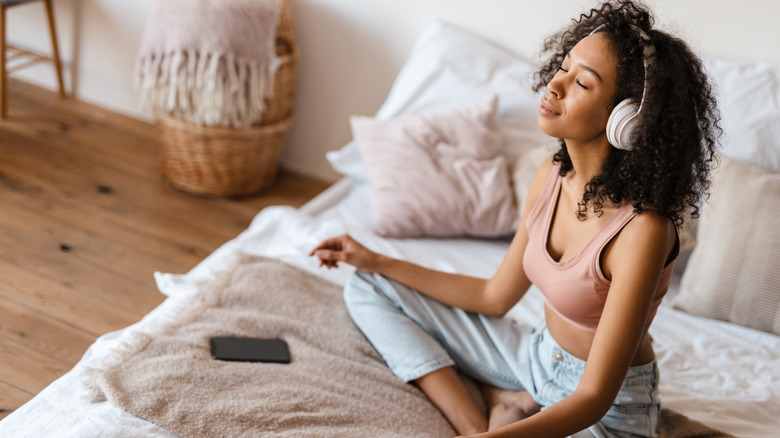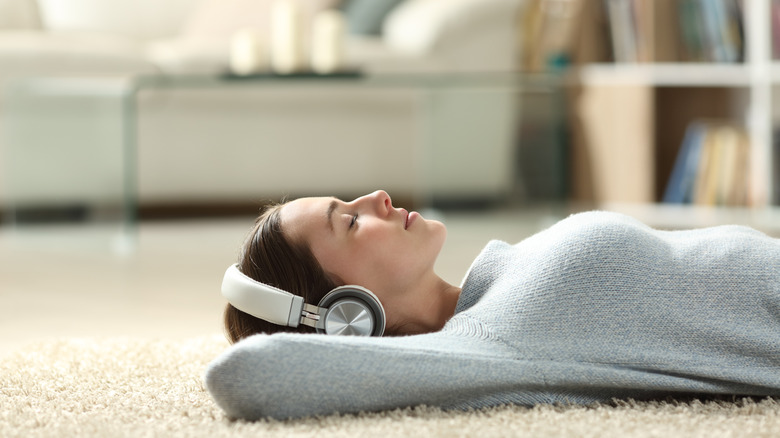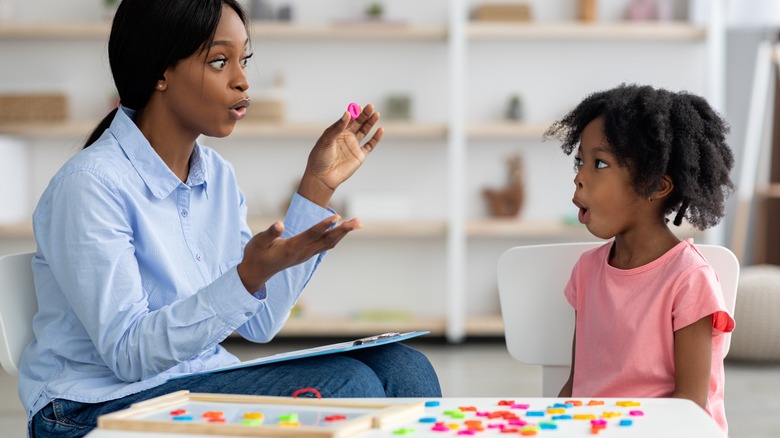Bilateral Stimulation Could Help Relieve Your Anxiety - Here's How
There's been an increase in the open conversation around anxiety and depression within wellness communities over the past few years — and that's a beautiful thing. Lessening the stigma around mental health issues has helped many seek treatment. That means you've likely heard some buzz phrases around healing, and bilateral stimulation may have been one of them.
The term refers to sensory stimuli which activate both sides of the brain. This could be visual, tactile, or auditory. The criss-cross effect is thought to calm the nervous system, integrate the processing of trauma, enhance positive thinking, and distance the mind from fixating on a difficult event or experience (via Anxiety Release).
Anxiety can wreak havoc on the nervous system, making it challenging to meet the demands of daily life — and to simply enjoy ourselves, even when demands are light. Living with anxiety is like being in fight or flight mode even when there is an obvious lack of threat or danger. It can be heartbreaking for both the anxious person and their loved ones. Let's take a closer look at the potential causes of anxiety and how bilateral stimulation can help.
Sources of anxiety
Anxiety can accumulate when we aren't able to process trauma or ongoing stress in a healthy way. We all have different levels of resiliency when it comes to carrying life's challenges. Some of us may need more healing than others. Anxiety can form as a result of stressful family dynamics, marital conflict, financial strain, parenting, childhood trauma, employment, friendships, illness, loss, or any other life-altering event. Whatever the cause, living with anxiety can rob us of life's many joys, gifts, and pleasures.
A certain amount of anxiety typically plays an important role in life (like protecting us from danger). But it's when this anxiety persists after the threat is gone that we may need additional help. Therapy, medication, self-care, or breathwork may all be advised by your mental health professional to manage your anxiety. You may even find that bilateral stimulation is also part of your treatment plan.
Visual bilateral stimulation
There are several types of bilateral stimuli. If you're familiar with any of them it's likely visual, or Eye Movement Desensitization and Reprocessing (EMDR) (via Evolution BHS). This is typically done in therapy by having the client follow an object in their visual space back and forth. The treatment eases the emotional response to painful memories and can help us process trauma. It's hypothesized that bilateral visual stimulation lessens the fear response of the mind. This is, of course, best accomplished with a licensed mental health professional.
The practice can also be used with young children where a toy or stuffed animal is used as the focal point. Even watching a tennis match or ping pong game would produce a similar experience. These eye movements are used to distance the painful emotions surrounding an event from the event itself. This allows the client some ease and a broader perspective of the trauma, ultimately understanding that we can certainly recover from painful events. Essentially, the vividness of the event will fade and healing can happen.
Auditory bilateral stimulation
You may have seen bilateral stimulation videos on TikTok where users share their experiences using the method to cope with conditions like ADHD. The effect is accomplished through headphones when the sound jumps from ear to ear — like in this video from user @vanessaltorre. When these tones cross the midline of the body, both hemispheres of the brain are activated (via Choosing Therapy). This calming sound therapy can bring a sense of peace and clarity to those who may struggle to focus.
There isn't as much research on auditory bilateral stimulation just yet, but many find the technique referred to as EMDR music — since it is based on the successful therapy technique (via Mama Has Her Mindful). Some claim to experience better sleep, a more peaceful mindset, and reduced anxiety from auditory bilateral stimulation. And the great thing about this tool is how easily accessible it is. All you need is a pair of headphones. You can find an array of bilateral stimulation audios on both Spotify and YouTube.
Tactile bilateral stimulation
You may find yourself engaging in tactile bilateral stimulation without even realizing it. We instinctively know that it soothes the nervous system. Rocking, swaying, patting, or tapping our knees can all be forms of bilateral stimulation. In therapy, a client may be directed to follow these patterns or have buzzers in each palm that create a similar effect.
A butterfly hug is often used in children's therapy. The client (child) crosses their arms and taps each arm for about thirty seconds. The simple practice can be done outside of therapy anytime the child begins to feel overwhelmed and needs to ground themselves (via Evolutions BHS). Studies have shown an impressive reduction in the body's stress levels after these bilateral stimulation techniques were utilized.
Hand drumming can also be an effective and fun method of bilateral stimulation for both kids and adults. The rhythmic patting and tapping using alternate hands can produce the same calming experience as other bilateral stimulation techniques.
Bilateral stimulation safety
While bilateral stimulation is a fairly simple and safe therapy for most, there are a few precautions to remember. Those who have sensory hypersensitivities could have an unexpected response to bilateral stimulation. If you've experienced brain injuries, migraines, complex PTSD, or Dissociative Identity Disorder, then it's best to consult with your therapist prior to experimenting with bilateral stimulation (via Anxiety Release).
When our attention is held during bilateral stimulation, we aren't able to focus on the difficult event we may have been fixated on. As the body relaxes, it now has space to store the memory in a different way. It's easy to see why this would be a great relief for some.
If you're unsure about the therapy technique, a trained EMDR therapist will best be able to guide you through bilateral stimulation and reap the benefits more thoroughly. The relief of anxiety, depression, and stress from those who engage in bilateral stimulation is certainly noteworthy. With various forms of alternative therapies on the rise, the practice is at least worth some consideration.





